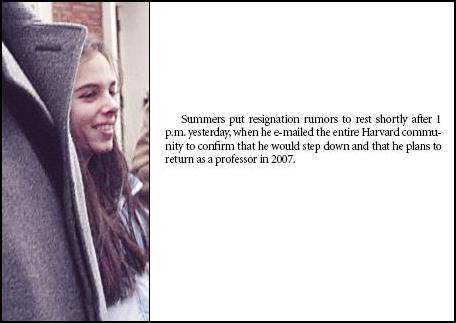|
The Crimson Passion:
A Drama at Mardi Gras continues. See Feb. 21 and 22 and the previous entry. In related news:  
|
Month: February 2006
-
Point Counter Point
From the Encyclopaedia Britannica, 11th Edition, 1911:
COUNTERPOINT (Lat. contrapunctus, "point counter point," "note against note")
"In music, the art happily defined by Sir Frederick Gore Ouseley as that 'of combining' melodies....
Double Counterpoint is a combination of melodies so designed that
either can be taken above or below the other. When this change of
position is effected by merely altering the OCTAVE (from Lat. octavus, eighth, octo, eight) of either or both melodies (with or without transposition of the whole combination to another KEY),
the artistic value of the device is simply that of the raising of
the lower melody to the surface. The harmonic scheme
remains the same, except in so far as some of the chords are not in
their fundamental position, while others, not originally fundamental,
have become so. But double counterpoint may be in other intervals than
the octave; that is to say, while one of the parts remains stationary,
the other may be transposed above or below it by some interval other
than an octave, thus producing an entirely different set of harmonies."See also Sybille Bedford's
biography of Aldous Huxleyand the entry below.
Related material:
A Contrapuntal Theme. -
Sudden View
From John O'Hara's Birthday:
"We stopped at the Trocadero and there was hardly anyone there. We
had Lanson 1926. 'Drink up, sweet. You gotta go some. How I love
music. Frère Jacques, Cuernavaca, ach du lieber August. All
languages. A walking Berlitz. Berlitz sounds like you with that
champagne, my sweet, or how you're gonna sound.'"— John O'Hara, Hope of Heaven, Chapter 11, 1938
"And they were all filled with the Holy Ghost, and began to speak with other tongues, as the Spirit gave them utterance."
"Lps. The keys to. Given! A way a lone a last a loved a long the
PARIS,
1922-1939."— James Joyce, conclusion of Finnegans Wake
"Using illustrative material from religion, myth, and culture, he
starts with the descent of the dove on Jesus and ends with the poetic
ramblings of James Joyce."— Review of a biography of the Holy Spirit
Monica Potts in today's New York Times on Sybille Bedford:
"Though her works were not always widely popular, they inspired a deeply
fervent following of committed admirers, starting with her first
published work, A Sudden View, in 1953. Later retitled A Visit to
Don Otavio, it was an account of her journey through Mexico."... "I addressed him. 'Is Cuernavaca not below Mexico City?'
'It is low.'
'Then what is this?' Another summit had sprung up above a curve.
'At your orders, the Three Marias.'
'What are the Three Marias?'
'These.'
Later, I learned from Terry that they were
the three peaks by the La Cima Pass which is indeed one of the highest
passes in the Republic; and still later from experience, that before
running down to anywhere in this country one must first run up some six
or seven thousand feet. The descents are more alarming than the
climbs. We hurtled towards Cuernavaca down unparapeted slopes
with the speed and angle, if not the precision, of a scenic railway--
cacti flashed past like telegraph poles, the sun was brilliant, the air
like laughing gas, below an enchanting valley, and the lack of
brakes became part of a general allegro accelerando."-- Sybille Bedford, A Sudden View, Counterpoint Press, Counterpoint edition (April 2003), page 77
"How continually, how startlingly, the landscape changed! Now the
fields were full of stones: there was a row of dead trees. An
abandoned plough, silhouetted against the sky, raised its arms to
heaven in mute supplication; another planet, he reflected again, a
strange planet where, if you looked a little further, beyond the Tres
Marias, you would find every sort of landscape at once, the Cotswolds,
Windermere, New Hampshire, the meadows of the Eure-et-Loire, even the
grey dunes of Cheshire, even the Sahara, a planet upon which, in the
twinkling of an eye, you could change climates, and, if you cared to
think so, in the crossing of a highway, three civilizations; but
beautiful, there was no denying its beauty, fatal or cleansing as it
happened to be, the beauty of the Earthly Paradise itself."-- Malcolm Lowry, Under the Volcano, Harper Perennial Modern Classics, 1st Perennial Classics edition (May 1, 2000), page 10
-
Final Club
For the feast of St. Matthias
(traditional calendar)--
from Amazon.com, a quoted Library Journal review of Geoffrey Wolff's novel The Final Club:
"'What other colleges call fraternities, Princeton calls Eating Clubs.
The Final Club is a group of 12 Princeton seniors in 1958 who make
their own, distinctive club....
Young adults may find this interesting, but older readers need not join The Final Club.'
-- Previewed in Prepub Alert, Library Journal 5/1/90. Paul E. Hutchison, Fisherman's Paradise, Bellefonte, Pa. Copyright 1990 Reed Business Information, Inc."From The Archivist, by Martha Cooley:
"Although I've always been called Matt, my first name isn't Matthew but
Matthias: after the disciple who replaced Judas Iscariot. By the
time I was four, I knew a great deal about my namesake. More than
once my mother read to me, from the New Testament, the story of how
Matthias had been chosen by lot to take the place of dreadful
Judas. Listening, I felt a large and frightened sympathy for my
predecessor. No doubt a dark aura hung over Judas's chair--
something like the pervasive, bitter odor of Pall Malls in my father's
corner of the sofa.
As far as my mother was concerned, the lot of
Matthias was the unquestionable outcome of an activity that seemed
capricious to me: a stone-toss by the disciples. I tried with
difficulty to picture a dozen men dressed in dust-colored robes and
sandals, playing a child's game. One of the Twelve had to carry
on, my mother explained, after Judas had perpetrated his evil.
The seat couldn't be left empty. Hence Matthias: the Lord's
servants had pitched their stones, and his had traveled the farthest." -
Headline in today's Harvard Crimson:
University at a
CrossroadsRelated material:

Instantia Crucis,
from
The Crucifixion
of John O'Hara
Book cover, 1938
See also The Crimson Passion. -
"In The Painted Word, a
rumination on the state of American painting in the 1970s, Tom Wolfe
described an epiphany...."-- Peter Berkowitz, "Literature in Theory"
"I had an epiphany."
-- Apostolos Doxiadis, organizer of last summer's conference on mathematics and narrative. See the Log24 entry of 1:06 PM last August 23 and the four entries that preceded it.
"... das
Durchleuchten des ewigen Glanzes des 'Einen' durch die materielle
Erscheinung"-- A definition of beauty from Plotinus, via Werner Heisenberg
"By groping toward the light we are made to realize
how deep the darkness is around us."-- Arthur Koestler, The Call Girls: A Tragi-Comedy,
Random House, 1973, page 118, quoted in The Shining of May 29"Perhaps we are meant to see the story as a cubist retelling of the crucifixion...."
-- Adam White Scoville, quoted in Cubist Crucifixion, on Iain Pears's novel, An Instance of the Fingerpost
-
A Kind of Temple
The page below is from
The Regenerate Lyric:
Theology and Innovation
in American Poetry,
by Elisa New.

Related material:
Log24, Oct. 5, 2005--
New Page for Harvard's President--
and the Harvard Crimson's
Wedding Bells Ring Anew for Summers.Related only through metaphor:
The Crucifixion of John O'Hara,
Appointment in Samarra,and Samarra Shrine.
-
In the Details"The groom wears
his boutonniere
on the left lapel,
nearest to his heart.
Buttonieres are generally
single blossoms
such as rosebuds."
Rosebud

Crimson photo by Vilsa E. Curto




Recent Comments